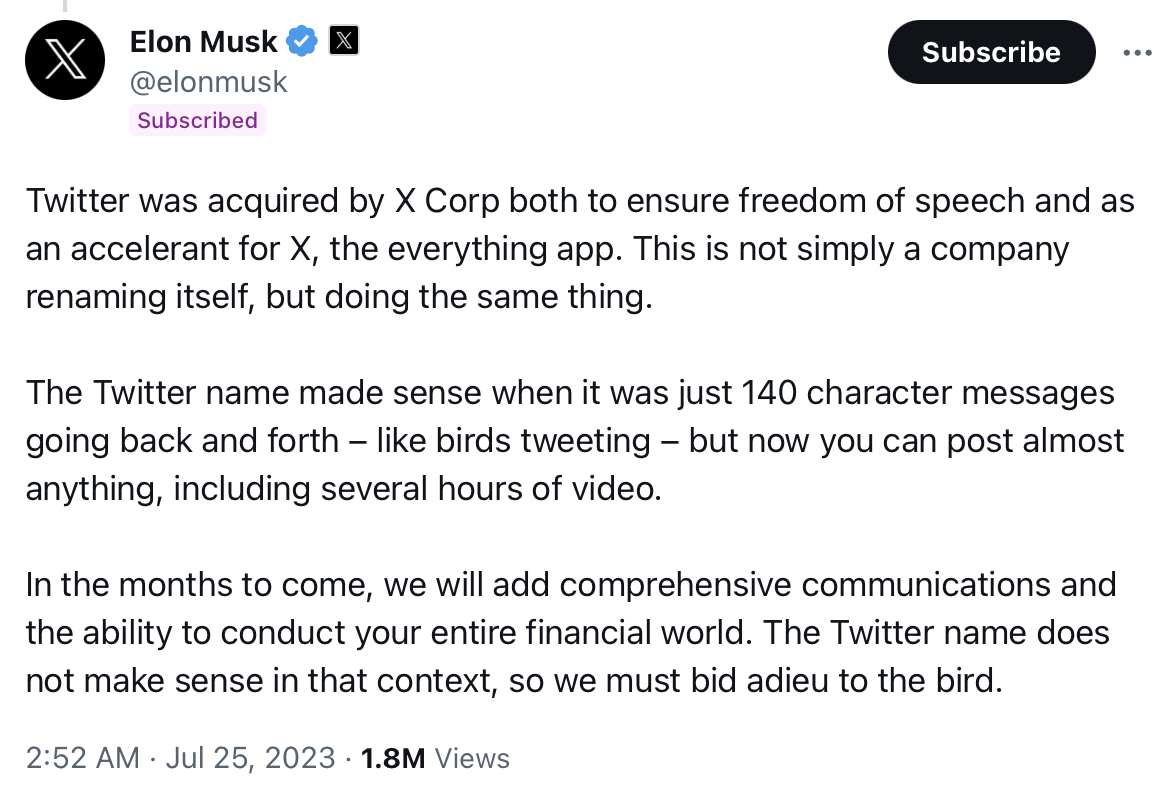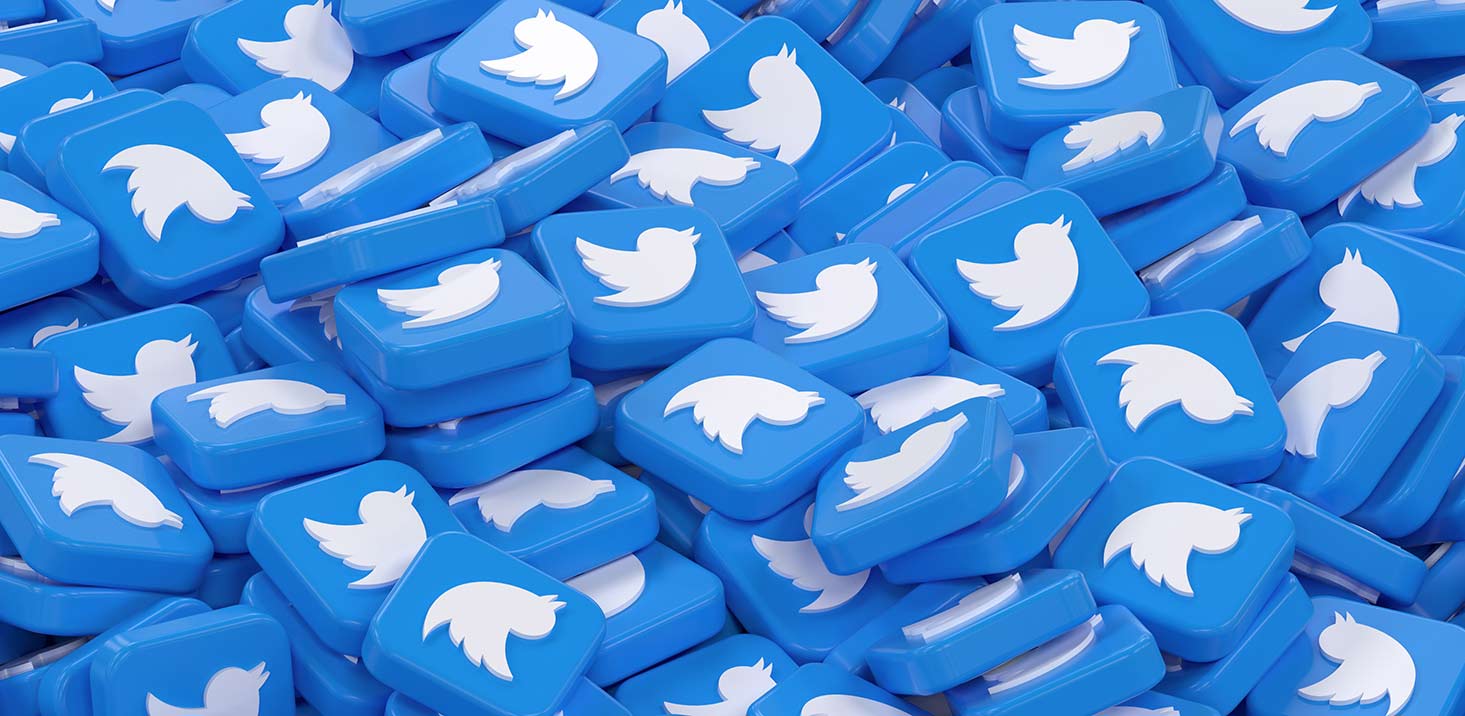Twitter’s rebranding: 5 lessons in what not to do
Rebranding 101 – do it in the right way and for the right reasons and you won’t go far wrong. It definitely shouldn’t be a decision that’s taken lightly or rushed. But that’s not something Elon Musk seems to have been worried about when Larry the Bird got the unceremonious chop last week.
The reason behind Twitter’s rebranding to X was the Twitter name ‘does not make sense’ now users can post content longer than 140 characters. Also, Elon wanted a name which more accurately reflects future plans to turn X into the ‘everything app’, which incorporates everything from comprehensive communications to the ability to conduct and manage all your finances.

On the face of it that all sounds (vaguely!) plausible, even sensible and there is definitely nothing wrong with making sure your brand reflects your new purpose. But, as one commentator remarked, this could be remembered as “one of the fastest unwinding of a business and brand ever”. So exactly why is this being cited as an unmitigated rebranding disaster? We take a look at 5 things you really, really shouldn’t do if you’re planning a rebrand.
1. Change your name on a whim
Snickers, Starburst, Wellness that Works, Choco Krispies. All brands who went through a name change for different reasons and with different degrees of success.
But if you are changing your name, whether it’s to achieve global consistency, for financial reasons or to ensure it represents your business more accurately, don’t forget one key detail – it’s a crucial part of your brand identity. Royal Mail forgot that nugget of advice when they decided to relaunch as Consignia, which is now simply a great case study on what not to do. So, has Twitter/X made the same mistake?
The thing is Twitter isn’t just a brand name or a logo. Twitter has done something other brands can only dream of: it’s become an integral part of our culture; has an identity everyone knows globally even if they don’t use the platform; and has introduced us to a whole new language – Tweet, Retweet, Twitterer, Tweeps (we’ll be interested to see how soon everyone is x-ing!).
This means this isn’t just about changing the name but about changing a whole brand identity, which has been built up over the last 17 years. A decision which you should never take lightly and is set to cost Twitter $20 billion in brand value.
2. Forget to check where you legally stand
Twitter/X isn’t new to legal challenges having faced a few in the last couple of months for failing to remove hate-filled tweets, but the last thing you need is for your new name to be accused of trademark infringement. Over 900 companies in various industries have X registered as a trademark, including Microsoft (Xbox) and Meta and we can’t imagine they will take it lying down.
And if X is challenged, they won’t be the first (or the last!) to face problems over their new name. When Titan Sports changed its name to the World Wrestling Federation (WWF), the World Wildlife Fund (WWF) wasn’t best pleased and wanted to protect their brand from an ‘unsavoury’ connection with wrestling. The legal battle took 13 years, with the panda winning in the end.
So, unless you want to be caught up in a protracted and expensive court case, do you due diligence before you pick a new brand name.
3. Launch at an inopportune time
The timing of the launch of X is, let’s just say, a bit odd. For one thing most companies going through a rebrand try and lay the groundwork well in advance, so that the market and customers can get used to the idea first. But Elon Musk simply tweeted (x-ed?) on Saturday that he was rebranding and two days later it was underway.
But as well as feeling a bit sudden and rushed, the timing seemed a bit off given it came hot on the heels of the launch of Threads, the “Twitter Killer”.
Within days the app had attracted more than 100 million sign-ups, apparently capitalising on users’ discontent with Twitter over technical issues, too much offensive content, and having to now buy verification badges.
In fact, back in December it was mooted that Twitter will lose 32m users in two years. Given Twitter’s questionable rebrand, that doesn’t seem too far-fetched, especially since there is a viable alternative ready and waiting for anyone who wants to jump ship.
4. Make changes as and when you feel like it
No matter the size of your brand it’s not easy making sure all the rebranding happens at the same time, especially if you have multiple assets across multiple countries. But you should at least try. Five days after the launch, Larry the Bird may have flown away from desktops, but he was still alive and tweeting on mobile devices. On App stores, you could still download Twitter instead of X and it’s a bit strange seeing a (boring!) black logo when all the other buttons and links are still in Twitter blue.
To be fair it’s obviously a phased roll-out, and it has just been announced that the platform will shortly only be available in ‘dark mode’ (nothing like taking away user choice!). But if your brand is going to face potential backlash against the change, it’s better to try and make sure it’s as seamless as possible. The last thing you want is to remind your customers what they are missing.
5. Try and do everything at once
Rebranding is a big exercise and should always involve reviewing your brand purpose to confirm what you stand for, why you exist, how you stand out from your competitors and how you connect with consumers on an emotional level (our workshops can help!). And while you may want to tweak your brand purpose be careful about doing too much all at once or as Mark Ritson so eloquently put it “Rebranding and repurposing and relaunching all at the same time smacks of desperation…”
The mistake Elon has made is to try and change the fundamental purpose of Twitter. It will no longer be a platform for sharing breaking news and entertainment alongside live commentary (let’s face it, that’s the best bit!) but rather become ‘the everything app’ which creates ‘a global marketplace for ideas, goods, services and opportunities’. What that means isn’t 100% clear, but it looks like Elon is copying China’s WeChat model and wants everything from messaging to accessing public services to be done under one app, that he just happens to own!
Obviously, it’s good to have long-term plans for your brand, but when you already have brand recognition, a strong customer base and brand equity be careful about doing too much at once. Let your users get used to your new identity before you change your brand’s purpose. And seriously question if you need to repurpose in the first place. When Weight Watchers chose to focus on wellness rather than weight, they lost 600,000 members simply because they had forgotten their brand purpose and what they were known for.
But maybe the biggest problem with Twitter/X’s repurposing is Elon himself. His personal brand is so inextricably interwoven with X’s corporate brand that inevitably what he’s proposing just feels like the delusional ramblings of a madman. Only time will tell whether Twitter/X is destined to become another classic marketing case study of what not to do, or if it’s the start of an exciting new era.
And if you are thinking of rebranding, our branding workshops can help ensure you definitely don’t make any of the mistakes listed above.
